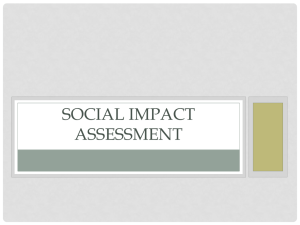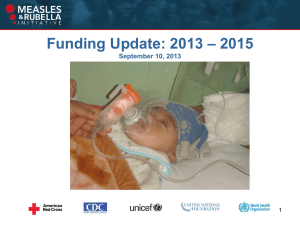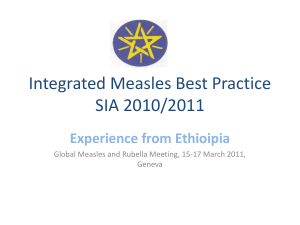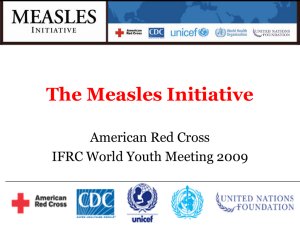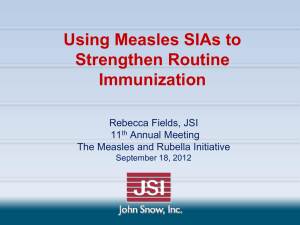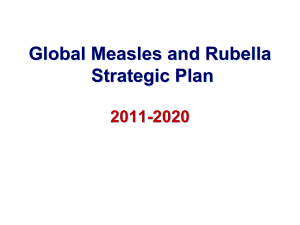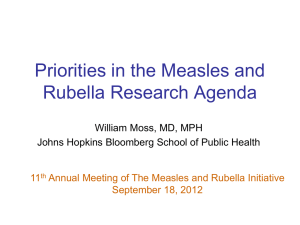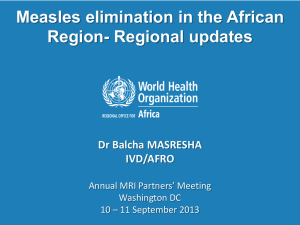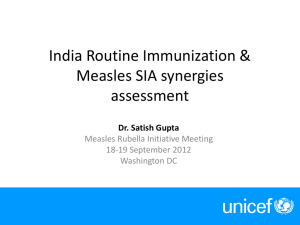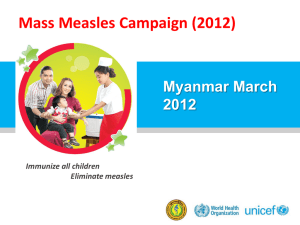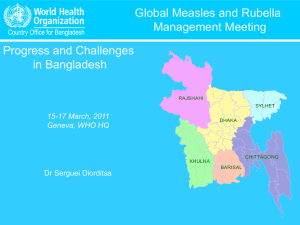Ethiopia`s Experience - Measles & Rubella Initiative
advertisement
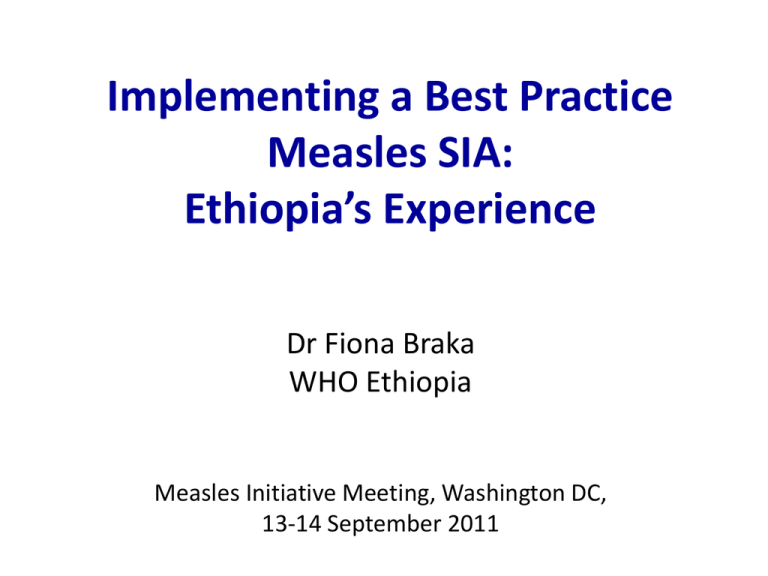
Implementing a Best Practice Measles SIA: Ethiopia’s Experience Dr Fiona Braka WHO Ethiopia Measles Initiative Meeting, Washington DC, 13-14 September 2011 Ethiopia: Background • Projected population 2010 (census 2007): 79 million – – – – Growth Rate: Under-1: Under-5: Under-15: 2.6% 3.2% (2.6m) 14.6% (11.4m) 45% (35m) Federal Ministry of Health Regional Health Bureau (9 Regions + 2 City Administrations) Zonal Health Administration (98 Zones) • Rural: 83% • Infant Mortality Rate: 75/1000 live-births Woreda Health Offices (819 Woredas) Kebeles/Health Post (15,000 HP, 1 per 5,000 popln) Measles cases and MCV1 admin coverage in Ethiopia, 1990 - 2010 Catch Up 2002 -2004 Follow Up 2005 - 2009 90 7000 80 6000 70 60 5000 50 4000 40 3000 30 2000 20 1000 10 0 0 Cases Measles Coverage Administrative Coverage (%) Number of Measles Cases 8000 Measles Epidemiology, Ethiopia, 2010 Age and vaxn status of confirmed measles cases. 2010 (n=3527) Spot map of confirmed measles cases. 2010 (n=3527) Second opportunity measles vaccination through SIAs Measles SIAs: 2010-2011 • Target: 8.5 million (9 – 47 months) • Phased in 2: – October 2010 (90.8%) – February 2011 (9.2%) • Integrated interventions: – OPV (0-59 months) – Vitamin A (6-59 months) – De-worming (24-59 months) – Nutritional Screening (6-59 months and pregnant and lactating women) 2010 2011 Best Practices SIAs Best Practices • “Best Practices” – Activities known to lead to predictably good results without using up too much resources – Based on local realities and challenges • Identified in Ethiopia through: – Extensive review of previous reports – Detailed internal consultations – Experiences from other AFR countries Areas of Focus for Best Practices • • • • • • • Coordination Micro planning and training Logistics Advocacy and communication Resource mobilization Monitoring and evaluation Strengthening routine EPI Coordination of the Best Practices SIA- Ethiopia • National Task Force (NTF) with subcommittees led by FMoH – NTF Chaired by FMoH DG – Weekly meetings started 5 months prior to SIAs – ~ 7 – 10 people in every meeting – Each meeting for >2hrs == >400 person-hours • Task Forces established at regional, zonal and woreda levels – weekly feedback to NTF Micro planning and Training • Work with Statistics Agency for best denominators • Focus on training quality – Pre/post testing – Participatory and practical – Schedule based on need not time allotment – Standard agenda • Evidence-based standard training materials: Field guide and translated pocket guides Health Workers (KAP) – local knowledge of needs – hard to reach populations KAP Survey Findings • 86% support the idea of SIAs • 55% know the importance of 2nd measles dose • 9% know how to estimate vaccine supplies Community Members (FGD) • Emphasis on Kebele level planning with • Few knew about SIAs • Most willing to vaccinate children • Major source of health information are HEW and kebele leaders Logistics • Required distribution of logistics 3-4 weeks before implementation • PFSA took on distribution role to Woreda level • Distribution flexibility including transport fleet for emergency distribution • Bundling of supplies Advocacy and Communication • Advocacy visits to Regional Presidents – 1-2 months prior to SIA – Joint team: FMoH and partners • Evidence-based messages • Sensitization and engagement of political leaders, Women’s Groups, Pediatric Society, Clinicians • Diverse channels of communication • Mass media: radio/ TV/ billboards, mobile vans • Town criers • Schools (notified via Ministry of Education) • Door to door visits by community volunteers (some places responsible for participation) Resource Mobilization • Government contributions • High level cooperation between EPI partners • Engagement of partners at all levels: o Human resources, transport, social mobilization, logistics Item Total Budget (USD) FMOH Nutrition Global Partners Polio To UNICEF (EOS) Initiative Measles Initiative To WHO Vaccine & injection materials 5,371,901 Operational costs 6,464,204 746,219 2,101,540 1,364,240 1,502,205 750,000 Grand Total 11,836,105 746,219 2,101,540 4,658,097 1,502,205 2,776,804 Target population (< 5) 12,859,245 3,345,097 Cost per child $0.92 2,026,804 Implementation • High level launch at national level by HE The President and at regional levels by Presidents/ dignified authorities • Approximately 178,320 vaccination teams including 66,870 health workers and more than 72,870 volunteers • Daily monitoring of performance through review meetings and SMS text messaging in phase 2 Monitoring • Pre campaign assessments (3-4 weeks and 1 week prior to SIA) and feedback given to address gaps • Different methods utilized to monitor performance: – Methods: Daily review meetings (with administration), supervision – Data Sources: Administrative, rapid convenience monitoring, independent monitoring • Improving data flow through use of SMS text messaging Multiple Data Sources (Tigray) Administrative follow-up measles SIAs coverage. Ethiopia. Admin coverage, 2010 - 2011 • 106% measles • 97% polio • >95% coverage: •93% measles - 81/95 (85%) Zones - 740/ 814 (91%) Woredas >=95% 90-94% 80-89% <80% Admin coverage, 2007- 2009 Independent Monitoring Assessment of Woreda Performance Proportion of Children missed in Evaluated Woreda Woredas Reaching Targets for Measles Vaccination Woredas Reaching Targets for Polio Vaccination >10% 106 (27%) 107 (27%) 5-10% 67(17%) 79 (20%) <5% 222 (56%) 209 (53%) Source of data: Post SIA Independent monitoring, 395 Woredas sampled Note: Poor quality finger markers compromised the independent monitoring process in many areas Evaluation of the SIA 1. Post SIA coverage survey o To assess coverage estimates for all interventions o 80 woredas in the 2 phases of the SIA; 4,420 children 2. Best practices evaluation o To determine best practices implemented and their effect on coverage o 20 woredas 3. Strengthening of routine EPI through the SIA o 4 regions: 8 zones; urban and rural representation 4. Impact assessment Post SIA Coverage Survey, 2010-2011 Phase 1: 87.8% Phase 2: 93.1% Limitations: assessment of finger marking compromised by quality of markers and timing of phase 1 survey; non availability of screening card in some areas Best Practices Evaluation Best practice activities Presence of enough vaccine carriers Appropriate cold chain Use of multiple locally available channels Task force meeting at all levels P-value Measles Coverage 0.044 Polio Coverage 0.005 Vitamin A coverage - De-worming coverage - 0.018 - - - - - 0.048 0.041 0.023 0.02 - - Enhancing Routine Immunization through SIAs • 7 key areas identified in the planning phase and efforts made to maximize on RI strengthening: 1. 2. 3. 4. 5. 6. 7. Micro planning Training Logistics Management Advocacy and Social Mobilization AEFI monitoring and management Surveillance Monitoring and Evaluation Impact of Measles SIAs on the Routine Immunisation System, Ethiopia. KAP Surveys Pre-SIA (6wks) vs Post-SIA (2wks) Survey Sites: 4 Regions; 2 zones/ region; urban & rural Addis Ababa Oromiya Pre-SIA Post SIA Pre-SIA Post-SIA SNNPR Pre-SIA Post SIA Somali Pre-SIA Post-SIA Monitoring chart up to date Health facilities with adequate functional cold chain 50% 63% 35% 99% 100% 100% 60% 64% 83% 100% 26% 22% 32% 14% 80% 80% Health facilities with adequate safety boxes 83% 92% 96% 99% 96% 100% 93% 100% Health workers who know the use of additional doses of measles immunization Health workers who know the correct site of measles vaccine injection 75% 92% 46% 74% 76% 100% 27% 87% 100% 100% 99% 94% 64% 96% 87% 87% Outcomes of the SIA Measles incidence, Ethiopia, 2006-2011 9 Number of Woredas with >5 Measles Cases/year 250 Woredas with >=5 Measles Cases/year 200 8 7.8 7 Measles Incidence 6 150 5 4.7 4 100 50 3.5 3.4 2.0 3 2 2.0 1 0 0 2006 Age shift (~70% above 5 years) 2007 2008 2009 2010 2011 Measles Incidence (per 100,000 population) Confirmed measles cases, Ethiopia, 2007-2011 Major Lessons Learned • Early identification of best practices at the country level • Strong federal government leadership and ownership • Micro planning should be bottom up o Include both technical and administrative officials o Adjustments after submission should be shared back down • Evidence-based social mobilization and training materials • Interpersonal communication (door-to-door where feasible) is effective • Daily intra campaign monitoring is essential for real-time results to ensure all children are reached. • Routine Immunization strengthening should be included in all aspects of planning, implementation and review, especially maintaining coordination structures Future Perspectives for Measles Elimination in Ethiopia • Consideration of wider age group for the next SIA in view of ongoing transmission • Local resource mobilisation for measles control efforts based on SIA experience • Partnerships forged and strengthened • Routine system strengthening o Use of SIA Coordination structures for future SIAs and routine EPI activities such as new vaccine introduction o Pre-SIA registration of target children and identification of hard to reach populations useful for subsequent SIA and RI o Capacity building of PFSA in logistics management o Local partnerships for RI and SIAs Acknowledgement • FMOH (Neghist Tesfaye) • Yodit Hailemariam • Balcha Masresha • Halima Dao • Meseret Eshetu • David Brown • Pascal Mkanda • Kathleen Wannemuehler • Gavin Grant • Theresa Diaz • Sisay Gashu • Edward Hoekstra • Luwei Pearson • Mitike Molla • Tirsit Assefa • National SIA Task Force • Habtamu Belete • MEDCO Acknowledgement Ethiopia Federal Ministry of Health Integrated Family Health Partnership JSI Research & Training Institute, Inc.
